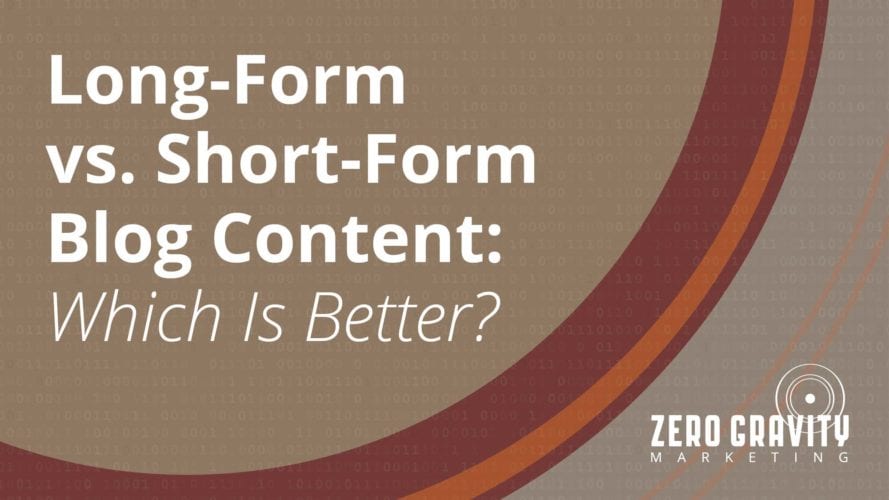When it comes to developing your content marketing strategy, you need to have a variety of quality content at your disposal. This often leaves marketers wondering whether long-form or short-form content is best for their overall marketing efforts.
While there’s no right or wrong answer, different situations and content marketing goals lend themselves to different post lengths. Let’s take a look at the pros and cons of long-form and short-form content and how to determine which to use.
Define Your Goals
Each piece of content you create must have a specific and achievable goal. Common content marketing goals can include:
- Generating Additional Backlinks
- Increasing Time On-Site
- Driving More Customers Through the Purchase Process
- Improving Search Engine Optimization (SEO)
Before you decide how long your particular piece should be, you must outline your individual goals for blog content. For example, do you want your content to increase brand awareness among customers in your industry? Or, perhaps you’d like to create a blog post that will generate sales leads for a specific product.
Once you’ve determined your goals, ask yourself where this particular topic falls in the buyer’s cycle. Are the customers learning more about your business, or are they ready to purchase right away? Your goals, as well as the topic’s position in the purchase process, will determine the length of your blog content.
The Pros and Cons of Long-Form Content
Most marketers prefer long-form content for its versatility. For instance, regardless of where your ideal customer is in the purchase cycle, long-form content works to educate them further on the topic. This often leads to users staying an average of 40 percent longer on your website!
More advantages of long-form content include:
- Thought Leader Positioning – Each 2,000+ word piece you create works to enhance your brand’s credibility online and establishes you as an expert in your field.
- Effective Keyword Use – Long-form content provides ample opportunities for the natural use of specific keywords, which, in turn, improves your ranking on search engines.
- Additional Social Media Shares – The more well-written and in-depth your long-form content is, the better chance you have of social media shares and interaction from interested users. Buzzsumo and OkDork recently partnered up to determine how to create viral content. Their examination found that long-form blogs were shared more often than shorter ones.
- Stronger Conversions – When your customers feel well informed after viewing your content, they’re more likely to be confident in their decisions. This leads to increased conversions.
The downsides of long-form content include the need for expert writers, time management, and additional resources. It takes a significant amount of time to create quality content that resonates with customers and achieves your goals. This content can only be developed by those with a strong expertise in writing, marketing, and the topic at hand.
Short-Form Content: Is It Worth It?
If long-form content is such a powerhouse for website traffic, social media, and SEO, is short-form content even worth it?
The answer is yes, but you must use it the right way.
Short-form posts can help achieve specific goals at distinct places within the customer buying cycle. For example, short-form content is ideal for qualified leads with existing knowledge of your products and services as well as the industry. They don’t need a wealth of information; they simply need help making a decision. A skilled copywriter can help create convincing short-form blog content that triggers potential customers to make the purchase. Plus, concise, well-written blogs can position you as an expert in your field and help you build a dedicated audience. This is especially important from a business-to-business (B2B) perspective.
In addition, if you know that your target audience is usually on-the-go, short-form content provides an easy and quick way to get the message across without too much scrolling. Finally, since short-form content takes less time to create, you can feasibly develop more of it to use throughout your content marketing strategy. Of course, you’ll still need to rely on expert writers to ensure that your content is of the highest quality.
Long vs. Short-Form Blog Content: Which Works for Your Strategy?
Although long-form content tends to have more advantages, short-form content can also be beneficial in many situations. The good news? It’s possible (and recommended) to include a mixture of both long- and short-form pieces in your content calendar. Just be sure to review your content marketing strategy and see where each type fits.
Need help identifying blog content opportunities? Zero Gravity Marketing can help. Contact us today to get in touch with our content marketing team.









